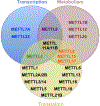METTLing in Stem Cell and Cancer Biology
- PMID: 36094754
- PMCID: PMC10563446
- DOI: 10.1007/s12015-022-10444-7
METTLing in Stem Cell and Cancer Biology
Abstract
The methyltransferase-like (METTL) family is a diverse group of methyltransferases that can methylate nucleotides, proteins, and small molecules. Despite this diverse array of substrates, they all share a characteristic seven-beta-strand catalytic domain, and recent evidence suggests many also share an important role in stem cell biology. The most well characterized family members METTL3 and METTL14 dimerize to form an N6-methyladenosine (m6A) RNA methyltransferase with established roles in cancer progression. However, new mouse models indicate that METTL3/METTL14 are also important for embryonic stem cell (ESC) development and postnatal hematopoietic and neural stem cell self-renewal and differentiation. METTL1, METTL5, METTL6, METTL8, and METTL17 also have recently identified roles in ESC pluripotency and differentiation, while METTL11A/11B, METTL4, METTL7A, and METTL22 have been shown to play roles in neural, mesenchymal, bone, and hematopoietic stem cell development, respectively. Additionally, a variety of other METTL family members are translational regulators, a role that could place them as important players in the transition from stem cell quiescence to differentiation. Here we will summarize what is known about the role of METTL proteins in stem cell differentiation and highlight the connection between their growing importance in development and their established roles in oncogenesis.
Keywords: Cancer; METTL; Metabolism; Methyltransferase; Stem cell; Transcription; Translation.
© 2022. The Author(s), under exclusive licence to Springer Science+Business Media, LLC, part of Springer Nature.
Conflict of interest statement
Figures



References
Publication types
MeSH terms
Substances
Grants and funding
LinkOut - more resources
Full Text Sources
Medical
Miscellaneous

